Financial Analysis Report: Stock Comparison and Investment Strategy
VerifiedAdded on 2023/06/03
|10
|1322
|152
Report
AI Summary
This report presents a comprehensive financial analysis of two stocks, General Dynamics (GD) and Boeing (BA), to determine which is the superior investment. The analysis begins with calculating returns and performing Jarque-Bera tests to assess the normality of returns. Hypothesis testing is then conducted to compare average returns and variances, using t-tests and F-tests. The Capital Asset Pricing Model (CAPM) is employed to analyze excess stock returns and market returns, with regression analysis used to estimate beta and R-squared values. The report interprets the results, comparing risk and return, and concludes with a recommendation. The report uses statistical methods, including confidence intervals and residual plots, to validate the findings and provide a well-supported investment recommendation. The analysis considers both statistical significance and practical implications to guide the investment decision.
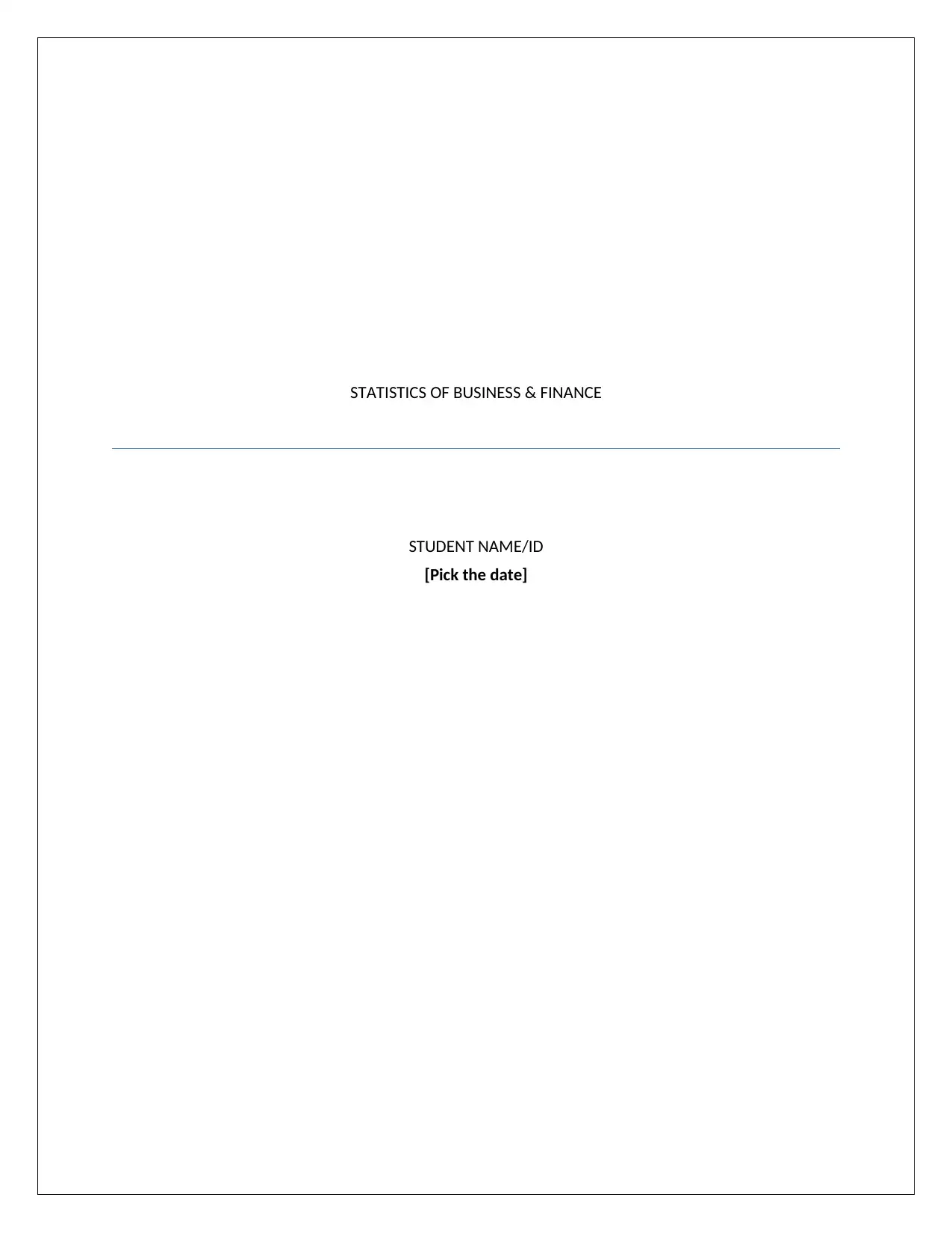
STATISTICS OF BUSINESS & FINANCE
STUDENT NAME/ID
[Pick the date]
STUDENT NAME/ID
[Pick the date]
Paraphrase This Document
Need a fresh take? Get an instant paraphrase of this document with our AI Paraphraser
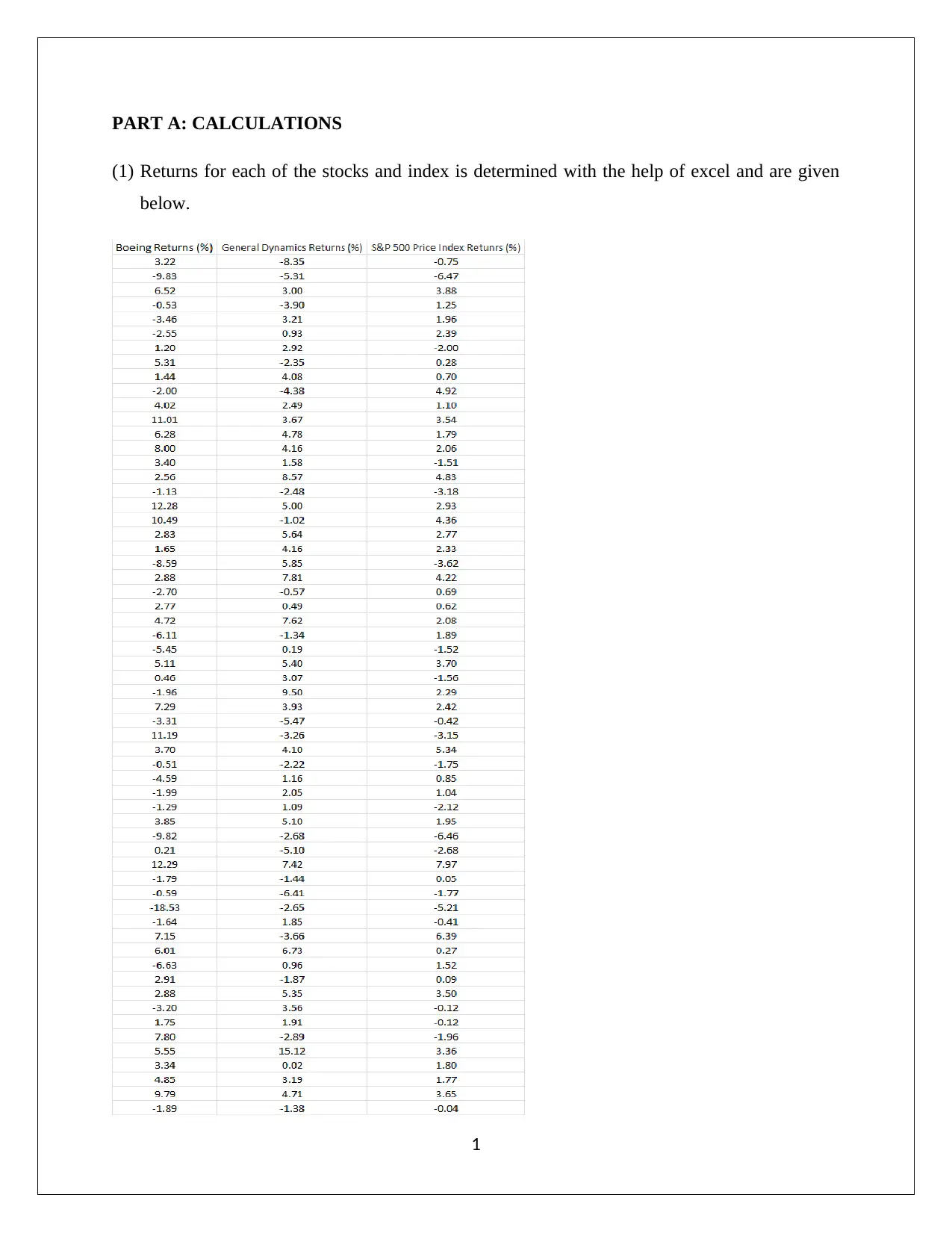
PART A: CALCULATIONS
(1) Returns for each of the stocks and index is determined with the help of excel and are given
below.
1
(1) Returns for each of the stocks and index is determined with the help of excel and are given
below.
1
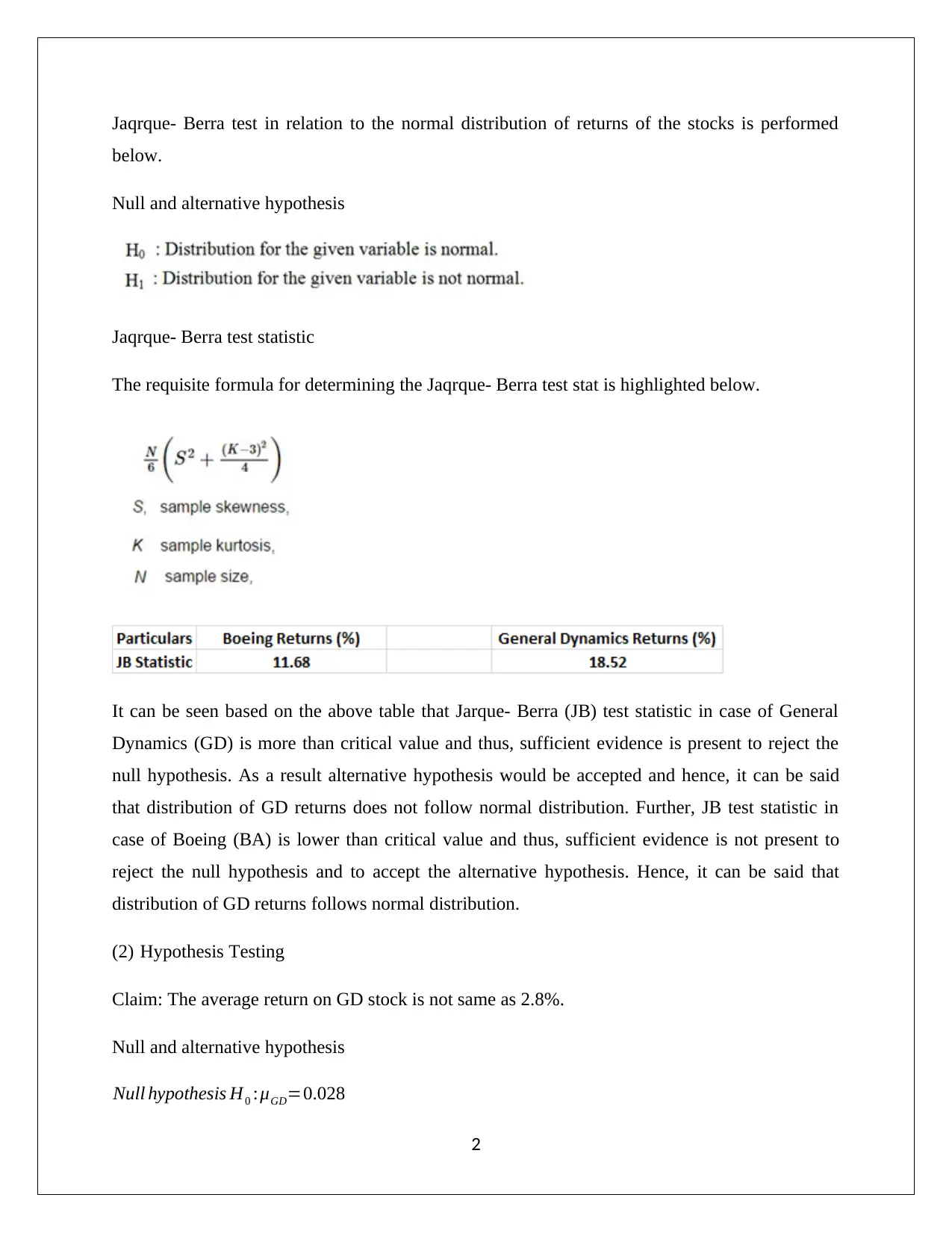
Jaqrque- Berra test in relation to the normal distribution of returns of the stocks is performed
below.
Null and alternative hypothesis
Jaqrque- Berra test statistic
The requisite formula for determining the Jaqrque- Berra test stat is highlighted below.
It can be seen based on the above table that Jarque- Berra (JB) test statistic in case of General
Dynamics (GD) is more than critical value and thus, sufficient evidence is present to reject the
null hypothesis. As a result alternative hypothesis would be accepted and hence, it can be said
that distribution of GD returns does not follow normal distribution. Further, JB test statistic in
case of Boeing (BA) is lower than critical value and thus, sufficient evidence is not present to
reject the null hypothesis and to accept the alternative hypothesis. Hence, it can be said that
distribution of GD returns follows normal distribution.
(2) Hypothesis Testing
Claim: The average return on GD stock is not same as 2.8%.
Null and alternative hypothesis
Null hypothesis H0 :μGD=0.028
2
below.
Null and alternative hypothesis
Jaqrque- Berra test statistic
The requisite formula for determining the Jaqrque- Berra test stat is highlighted below.
It can be seen based on the above table that Jarque- Berra (JB) test statistic in case of General
Dynamics (GD) is more than critical value and thus, sufficient evidence is present to reject the
null hypothesis. As a result alternative hypothesis would be accepted and hence, it can be said
that distribution of GD returns does not follow normal distribution. Further, JB test statistic in
case of Boeing (BA) is lower than critical value and thus, sufficient evidence is not present to
reject the null hypothesis and to accept the alternative hypothesis. Hence, it can be said that
distribution of GD returns follows normal distribution.
(2) Hypothesis Testing
Claim: The average return on GD stock is not same as 2.8%.
Null and alternative hypothesis
Null hypothesis H0 :μGD=0.028
2
⊘ This is a preview!⊘
Do you want full access?
Subscribe today to unlock all pages.

Trusted by 1+ million students worldwide
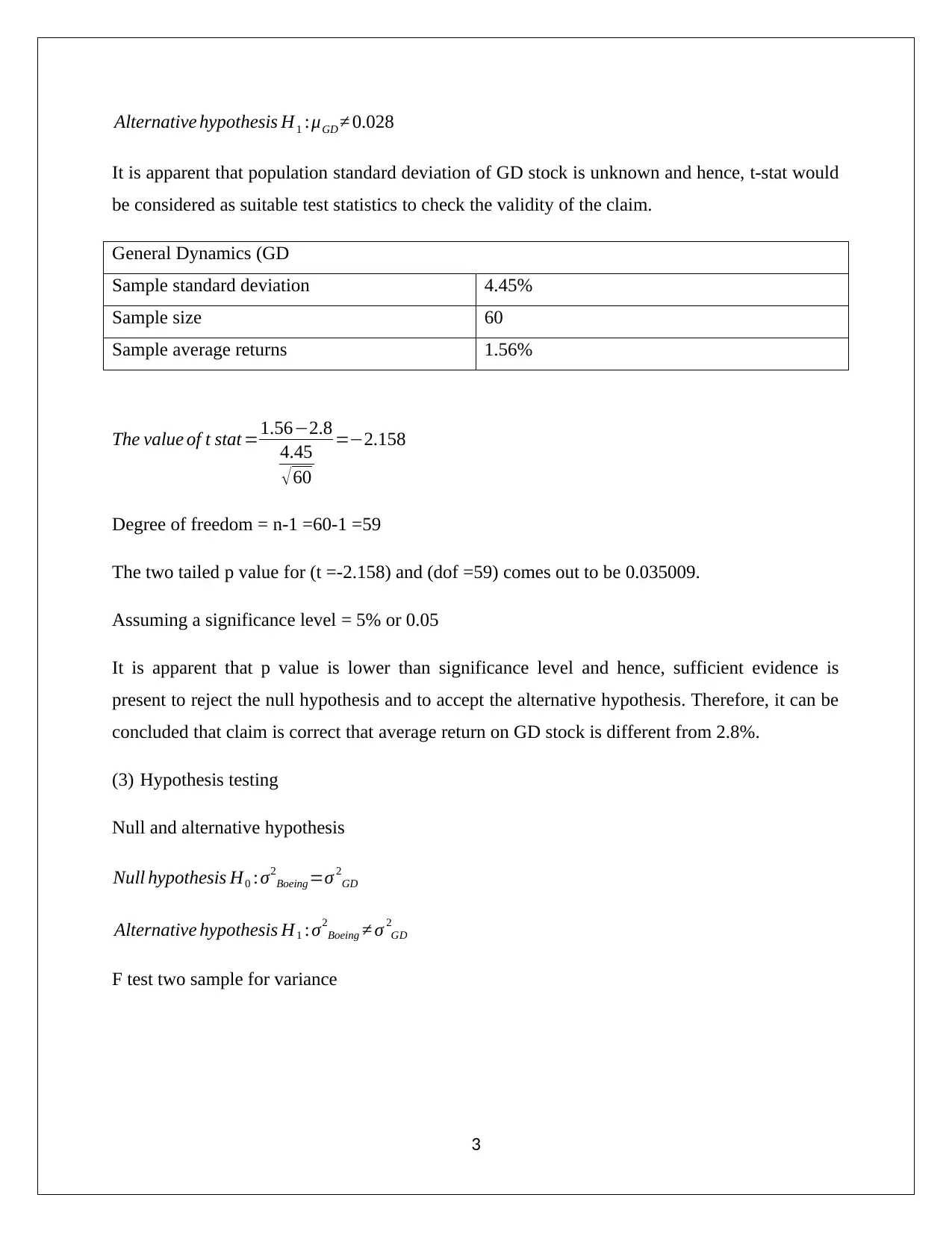
Alternative hypothesis H1 :μGD ≠ 0.028
It is apparent that population standard deviation of GD stock is unknown and hence, t-stat would
be considered as suitable test statistics to check the validity of the claim.
General Dynamics (GD
Sample standard deviation 4.45%
Sample size 60
Sample average returns 1.56%
The value of t stat =1.56−2.8
4.45
√ 60
=−2.158
Degree of freedom = n-1 =60-1 =59
The two tailed p value for (t =-2.158) and (dof =59) comes out to be 0.035009.
Assuming a significance level = 5% or 0.05
It is apparent that p value is lower than significance level and hence, sufficient evidence is
present to reject the null hypothesis and to accept the alternative hypothesis. Therefore, it can be
concluded that claim is correct that average return on GD stock is different from 2.8%.
(3) Hypothesis testing
Null and alternative hypothesis
Null hypothesis H0 :σ2
Boeing=σ 2
GD
Alternative hypothesis H1 :σ2
Boeing ≠ σ 2
GD
F test two sample for variance
3
It is apparent that population standard deviation of GD stock is unknown and hence, t-stat would
be considered as suitable test statistics to check the validity of the claim.
General Dynamics (GD
Sample standard deviation 4.45%
Sample size 60
Sample average returns 1.56%
The value of t stat =1.56−2.8
4.45
√ 60
=−2.158
Degree of freedom = n-1 =60-1 =59
The two tailed p value for (t =-2.158) and (dof =59) comes out to be 0.035009.
Assuming a significance level = 5% or 0.05
It is apparent that p value is lower than significance level and hence, sufficient evidence is
present to reject the null hypothesis and to accept the alternative hypothesis. Therefore, it can be
concluded that claim is correct that average return on GD stock is different from 2.8%.
(3) Hypothesis testing
Null and alternative hypothesis
Null hypothesis H0 :σ2
Boeing=σ 2
GD
Alternative hypothesis H1 :σ2
Boeing ≠ σ 2
GD
F test two sample for variance
3
Paraphrase This Document
Need a fresh take? Get an instant paraphrase of this document with our AI Paraphraser
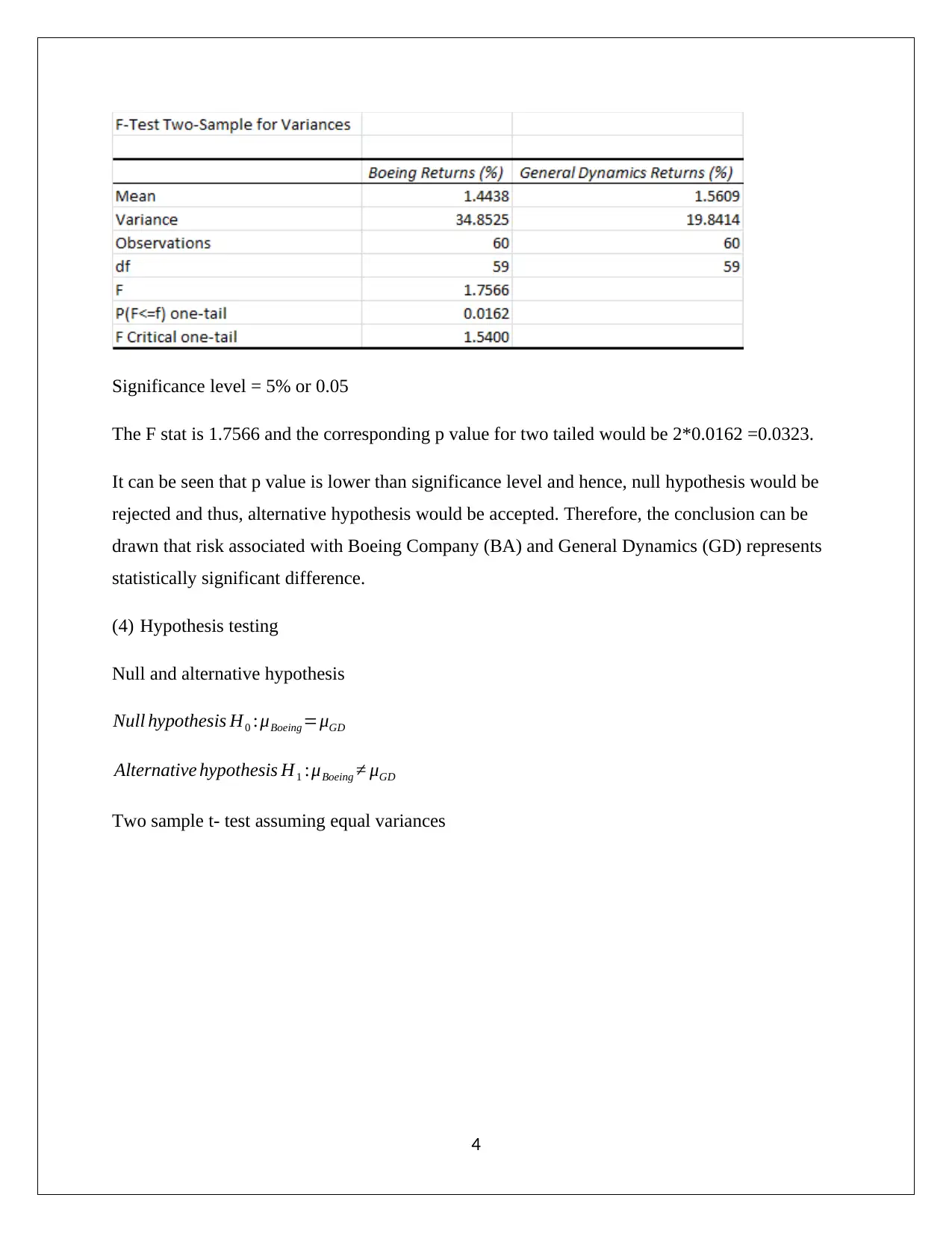
Significance level = 5% or 0.05
The F stat is 1.7566 and the corresponding p value for two tailed would be 2*0.0162 =0.0323.
It can be seen that p value is lower than significance level and hence, null hypothesis would be
rejected and thus, alternative hypothesis would be accepted. Therefore, the conclusion can be
drawn that risk associated with Boeing Company (BA) and General Dynamics (GD) represents
statistically significant difference.
(4) Hypothesis testing
Null and alternative hypothesis
Null hypothesis H0 :μBoeing =μGD
Alternative hypothesis H1 :μBoeing ≠ μGD
Two sample t- test assuming equal variances
4
The F stat is 1.7566 and the corresponding p value for two tailed would be 2*0.0162 =0.0323.
It can be seen that p value is lower than significance level and hence, null hypothesis would be
rejected and thus, alternative hypothesis would be accepted. Therefore, the conclusion can be
drawn that risk associated with Boeing Company (BA) and General Dynamics (GD) represents
statistically significant difference.
(4) Hypothesis testing
Null and alternative hypothesis
Null hypothesis H0 :μBoeing =μGD
Alternative hypothesis H1 :μBoeing ≠ μGD
Two sample t- test assuming equal variances
4
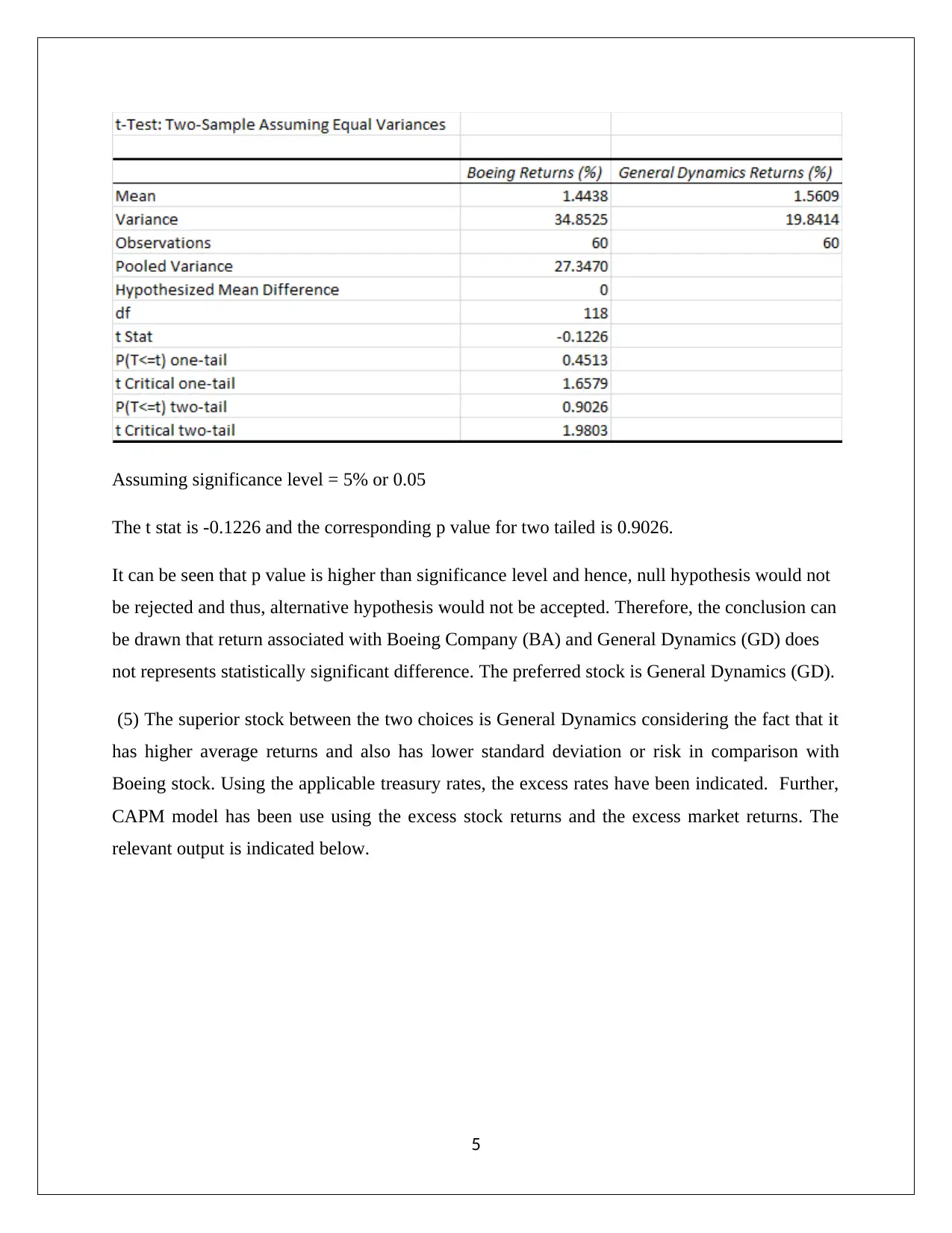
Assuming significance level = 5% or 0.05
The t stat is -0.1226 and the corresponding p value for two tailed is 0.9026.
It can be seen that p value is higher than significance level and hence, null hypothesis would not
be rejected and thus, alternative hypothesis would not be accepted. Therefore, the conclusion can
be drawn that return associated with Boeing Company (BA) and General Dynamics (GD) does
not represents statistically significant difference. The preferred stock is General Dynamics (GD).
(5) The superior stock between the two choices is General Dynamics considering the fact that it
has higher average returns and also has lower standard deviation or risk in comparison with
Boeing stock. Using the applicable treasury rates, the excess rates have been indicated. Further,
CAPM model has been use using the excess stock returns and the excess market returns. The
relevant output is indicated below.
5
The t stat is -0.1226 and the corresponding p value for two tailed is 0.9026.
It can be seen that p value is higher than significance level and hence, null hypothesis would not
be rejected and thus, alternative hypothesis would not be accepted. Therefore, the conclusion can
be drawn that return associated with Boeing Company (BA) and General Dynamics (GD) does
not represents statistically significant difference. The preferred stock is General Dynamics (GD).
(5) The superior stock between the two choices is General Dynamics considering the fact that it
has higher average returns and also has lower standard deviation or risk in comparison with
Boeing stock. Using the applicable treasury rates, the excess rates have been indicated. Further,
CAPM model has been use using the excess stock returns and the excess market returns. The
relevant output is indicated below.
5
⊘ This is a preview!⊘
Do you want full access?
Subscribe today to unlock all pages.

Trusted by 1+ million students worldwide
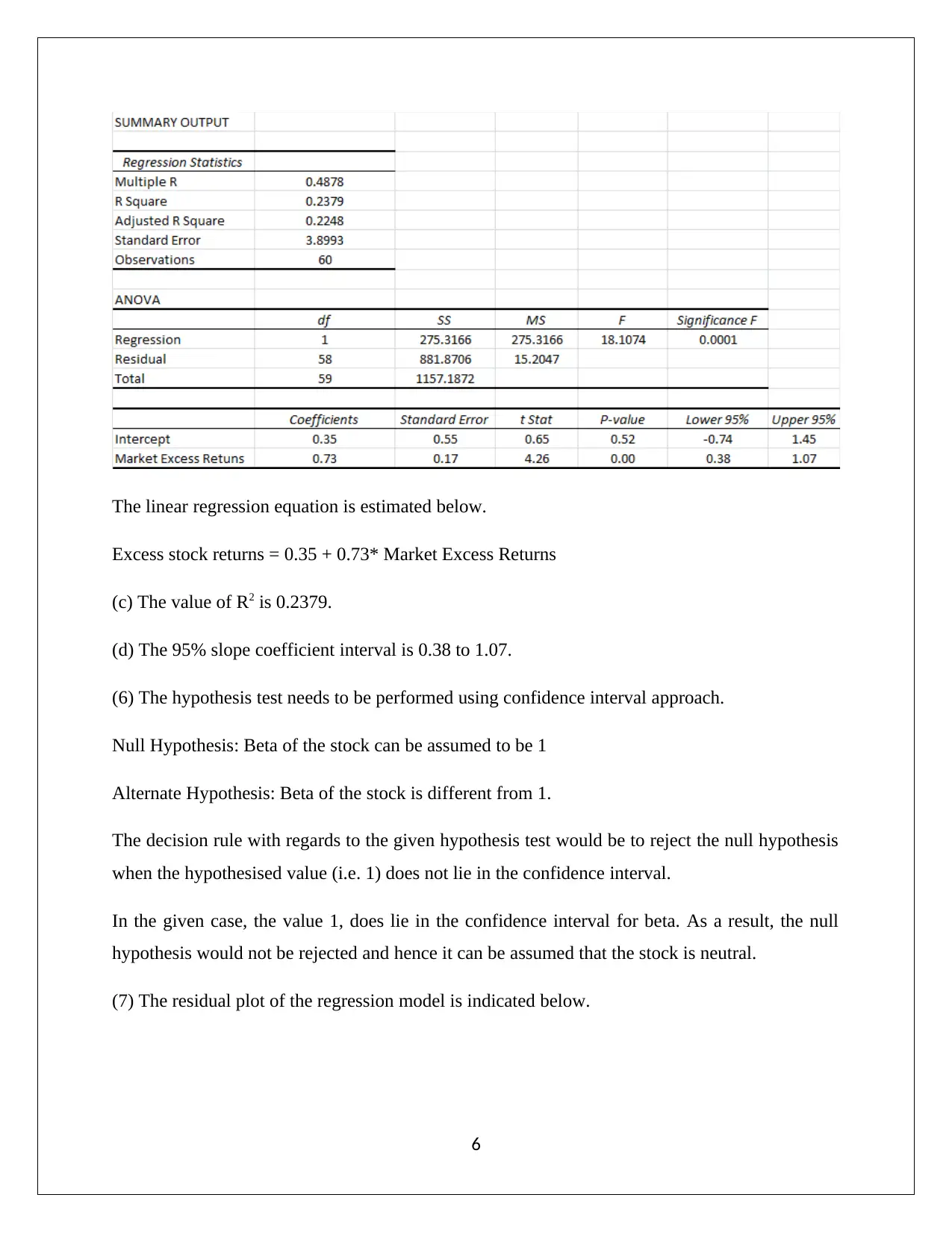
The linear regression equation is estimated below.
Excess stock returns = 0.35 + 0.73* Market Excess Returns
(c) The value of R2 is 0.2379.
(d) The 95% slope coefficient interval is 0.38 to 1.07.
(6) The hypothesis test needs to be performed using confidence interval approach.
Null Hypothesis: Beta of the stock can be assumed to be 1
Alternate Hypothesis: Beta of the stock is different from 1.
The decision rule with regards to the given hypothesis test would be to reject the null hypothesis
when the hypothesised value (i.e. 1) does not lie in the confidence interval.
In the given case, the value 1, does lie in the confidence interval for beta. As a result, the null
hypothesis would not be rejected and hence it can be assumed that the stock is neutral.
(7) The residual plot of the regression model is indicated below.
6
Excess stock returns = 0.35 + 0.73* Market Excess Returns
(c) The value of R2 is 0.2379.
(d) The 95% slope coefficient interval is 0.38 to 1.07.
(6) The hypothesis test needs to be performed using confidence interval approach.
Null Hypothesis: Beta of the stock can be assumed to be 1
Alternate Hypothesis: Beta of the stock is different from 1.
The decision rule with regards to the given hypothesis test would be to reject the null hypothesis
when the hypothesised value (i.e. 1) does not lie in the confidence interval.
In the given case, the value 1, does lie in the confidence interval for beta. As a result, the null
hypothesis would not be rejected and hence it can be assumed that the stock is neutral.
(7) The residual plot of the regression model is indicated below.
6
Paraphrase This Document
Need a fresh take? Get an instant paraphrase of this document with our AI Paraphraser
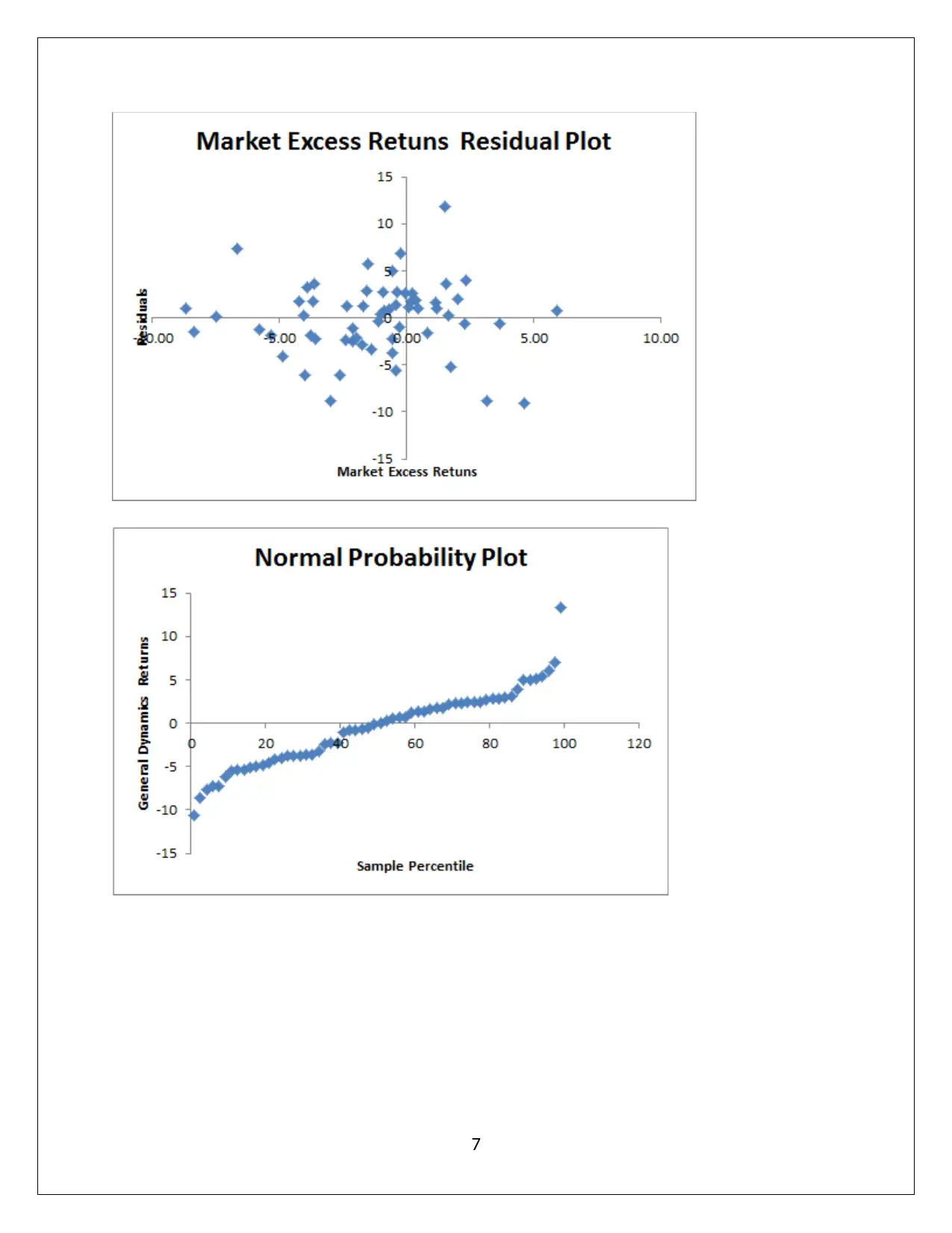
7

PART B: Interpretation
(1) Typically risk and returns are interrelated since higher returns are expected on assets having
higher risk. In the given case, the higher average monthly returns are for General Dynamics
stock in comparison with Boeing stock. Further, the risk of the stock is measured by the standard
deviation of the stock returns. The risk is higher for Boeing which tends to have a larger
dispersion in the monthly return values in comparison to the General Dynamics. It is apparent
from the above analysis that the superior stock is General Dynamics between the given stock
since it offers higher returns at lower risk.
(3) The risk associated with the two stocks is different as has been validated by the relevant
hypothesis test. Also, taking into consideration the sample risk data, it is apparent that the sample
risk would be higher for Boeing stock as compared to General Dynamics stock.
(4) The average returns associated for the two stocks does not highlight any significant
difference and hence these are not different. While the population returns for the two stocks are
not different, the underlying risk is different. Thus, the stock with lower risk would be preferable
which would be General Dynamics.
(5) (b) The beta from the CAPM output has come out as 0.73. This implies that for a percentage
change in the excess returns of the market, a 0.73% return would be observed in the excess stock
returns. Both the changes would be in the same direction.
(c) The R2 value is 0.2379 which implies that 23.79% of the variation in excess returns on the
GD stock can be explained on account of variation in the market.
(d) The 95% confidence suggests that the beta of the GD stock would lie between 0.38 and 1.07
with a probability of 0.95.
(6) The hypothesis test using the above confidence interval suggests that the stock can be
assumed as neutral as the beta of the GD stock can be 1 since it is included in the confidence
interval estimated above.
8
(1) Typically risk and returns are interrelated since higher returns are expected on assets having
higher risk. In the given case, the higher average monthly returns are for General Dynamics
stock in comparison with Boeing stock. Further, the risk of the stock is measured by the standard
deviation of the stock returns. The risk is higher for Boeing which tends to have a larger
dispersion in the monthly return values in comparison to the General Dynamics. It is apparent
from the above analysis that the superior stock is General Dynamics between the given stock
since it offers higher returns at lower risk.
(3) The risk associated with the two stocks is different as has been validated by the relevant
hypothesis test. Also, taking into consideration the sample risk data, it is apparent that the sample
risk would be higher for Boeing stock as compared to General Dynamics stock.
(4) The average returns associated for the two stocks does not highlight any significant
difference and hence these are not different. While the population returns for the two stocks are
not different, the underlying risk is different. Thus, the stock with lower risk would be preferable
which would be General Dynamics.
(5) (b) The beta from the CAPM output has come out as 0.73. This implies that for a percentage
change in the excess returns of the market, a 0.73% return would be observed in the excess stock
returns. Both the changes would be in the same direction.
(c) The R2 value is 0.2379 which implies that 23.79% of the variation in excess returns on the
GD stock can be explained on account of variation in the market.
(d) The 95% confidence suggests that the beta of the GD stock would lie between 0.38 and 1.07
with a probability of 0.95.
(6) The hypothesis test using the above confidence interval suggests that the stock can be
assumed as neutral as the beta of the GD stock can be 1 since it is included in the confidence
interval estimated above.
8
⊘ This is a preview!⊘
Do you want full access?
Subscribe today to unlock all pages.

Trusted by 1+ million students worldwide

(7) From the residual plot, it is apparent that the various points are scattered in a random manner
and do not have a particular pattern and thereby it can be estimated that the error terms are
normal distributed. The normal probability plot also supports the same conclusion.
9
and do not have a particular pattern and thereby it can be estimated that the error terms are
normal distributed. The normal probability plot also supports the same conclusion.
9
1 out of 10
Related Documents
Your All-in-One AI-Powered Toolkit for Academic Success.
+13062052269
info@desklib.com
Available 24*7 on WhatsApp / Email
![[object Object]](/_next/static/media/star-bottom.7253800d.svg)
Unlock your academic potential
Copyright © 2020–2025 A2Z Services. All Rights Reserved. Developed and managed by ZUCOL.

![Statistical Analysis of Business and Finance Data - [Semester]](/_next/image/?url=https%3A%2F%2Fdesklib.com%2Fmedia%2Fbusiness-finance-statistics-hypothesis-interpretation_page_2.jpg&w=256&q=75)

